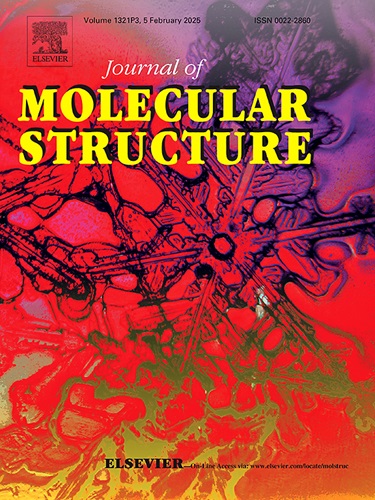Synthesis, characterization, proteolytic activity inhibition, ADMET prediction, and molecular docking studies of novel indole derivatives as potential SARS-CoV-2 protease inhibitors
IF 4
2区 化学
Q2 CHEMISTRY, PHYSICAL
引用次数: 0
Abstract
Both the main protease (Mpro) and papain protease (PLpro) are fundamental enzymes in SARS-CoV-2 life cycle. In this study, we have targeted these two enzymes using novel indole derivatives as antiviral agents. The synthesized compounds were thoroughly characterized by Fourier-transform infrared spectroscopy (FT-IR), UV–vis, 1H, 13C, and 2D nuclear magnetic resonance (NMR), high-resolution mass spectrometry (HRMS), and melting point (m.p.). The optimized structure, reactivity, and stability of the synthesized compounds were calculated using Density Functional Theory (DFT) at the B3LYP/6–31G(d,p) level. Using in silico ADMET prediction along with molecular docking, we found that the synthesized compounds presented good docking scores and very low predicted inhibition constants (Pki) from low micromolar to nanomolar ranges. In particular, compounds 10 and 11 with respective Pki values of 1.68 μM and 387.71 nM for Mpro and 402.50 nM and 27.10 nM for PLpro. These two compounds are engaged in vast range of interactions with the active sites of both enzymes. Further in vitro investigations using fluorescence resonance energy transfer (FRET) assays demonstrated that compounds 10 and 11 inhibited Mpro proteolytic activity with approximate IC50 values of 20 µM and 10 µM, respectively. These findings suggest that these new indole derivatives could serve as promising candidates for the development of drugs against SARS-CoV-2 and potentially other future coronaviruses.
作为潜在 SARS-CoV-2 蛋白酶抑制剂的新型吲哚衍生物的合成、表征、蛋白水解活性抑制、ADMET 预测和分子对接研究
主蛋白酶(Mpro)和木瓜蛋白酶(PLpro)都是 SARS-CoV-2 生命周期中的基本酶。在本研究中,我们利用新型吲哚衍生物作为抗病毒药物,靶向作用于这两种酶。通过傅立叶变换红外光谱(FT-IR)、紫外-可见光谱、1H、13C 和二维核磁共振(NMR)、高分辨质谱(HRMS)和熔点(m.p.)对合成的化合物进行了全面的表征。利用密度泛函理论(DFT)在 B3LYP/6-31G(d,p)水平上计算了合成化合物的优化结构、反应活性和稳定性。通过分子对接和默观 ADMET 预测,我们发现合成的化合物具有良好的对接得分,从低微摩尔到纳摩尔范围内的预测抑制常数(Pki)都非常低。其中,化合物 10 和 11 对 Mpro 的 Pki 值分别为 1.68 μM 和 387.71 nM,对 PLpro 的 Pki 值分别为 402.50 nM 和 27.10 nM。这两种化合物与这两种酶的活性位点发生了广泛的相互作用。利用荧光共振能量转移(FRET)测定法进行的进一步体外研究表明,化合物 10 和 11 可抑制 Mpro 的蛋白水解活性,其 IC50 值分别约为 20 µM 和 10 µM。这些研究结果表明,这些新的吲哚衍生物有望成为开发抗 SARS-CoV-2 以及未来其他冠状病毒药物的候选化合物。
本文章由计算机程序翻译,如有差异,请以英文原文为准。
求助全文
约1分钟内获得全文
求助全文
来源期刊

Journal of Molecular Structure
化学-物理化学
CiteScore
7.10
自引率
15.80%
发文量
2384
审稿时长
45 days
期刊介绍:
The Journal of Molecular Structure is dedicated to the publication of full-length articles and review papers, providing important new structural information on all types of chemical species including:
• Stable and unstable molecules in all types of environments (vapour, molecular beam, liquid, solution, liquid crystal, solid state, matrix-isolated, surface-absorbed etc.)
• Chemical intermediates
• Molecules in excited states
• Biological molecules
• Polymers.
The methods used may include any combination of spectroscopic and non-spectroscopic techniques, for example:
• Infrared spectroscopy (mid, far, near)
• Raman spectroscopy and non-linear Raman methods (CARS, etc.)
• Electronic absorption spectroscopy
• Optical rotatory dispersion and circular dichroism
• Fluorescence and phosphorescence techniques
• Electron spectroscopies (PES, XPS), EXAFS, etc.
• Microwave spectroscopy
• Electron diffraction
• NMR and ESR spectroscopies
• Mössbauer spectroscopy
• X-ray crystallography
• Charge Density Analyses
• Computational Studies (supplementing experimental methods)
We encourage publications combining theoretical and experimental approaches. The structural insights gained by the studies should be correlated with the properties, activity and/ or reactivity of the molecule under investigation and the relevance of this molecule and its implications should be discussed.
 求助内容:
求助内容: 应助结果提醒方式:
应助结果提醒方式:


